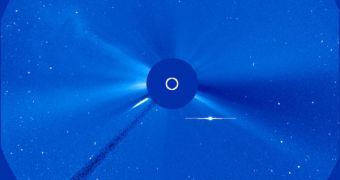Throughout last month, solar physicists keeping an eye on the Sun have discovered more than 25 small comets slamming straight into the star. They now say that this mob of celestial bodies may in fact be the herald of a much larger comet heading for the solar surface.
The incoming body, they say, could be so large that it would become visible to the naked eye. They add that all the small comets hit the Sun within a relatively short period of time, of only 10 days.
Sungrazers (comets that dive into the solar surface) are not unknown to science, and are not uncommon occurrences in the solar system. According to experts who monitor the star, one such body hits its surface, and disintegrates once every few days.
The Solar and Heliospheric Observatory (SOHO) spacecraft, which is equipped with a suite of scientific instruments that can monitor many aspects of the Sun at once, usually detects such bodies at regular intervals.
“But 25 comets in just ten days, that's unprecedented,” explains in a statement Karl Battams, who is based in Washington DC, at the Naval Research Lab (NRL).
“The storm began on December 13th and ended on the 22nd. During that time, the Solar and Heliospheric Observatory (SOHO) detected 25 comets diving into the sun. It was crazy!” he adds.
Scientists operating the Lowell Observatory, in Flagstaff, Arizona, say that the comets which slammed into the Sun were the size of a large room, or a small house, and had diameters in the 10-meter class. The experts add that these comets are considered small by all standards.
Based on events that unfolded in the past, solar physicists hypothesize that a larger sungrazer may lurk in the solar system, ready to plummet into the Sun itself. “It's just a matter of time. We know there are some big ones out there,” Battams says, quoted by Space.
Large comets of this type were observed in 1843, 1882, 1963, 1965 and 1970. They were visible from Earth with the naked eye, right next to the Sun. If the objects are large enough, they survive the stellar encounter, and recede back into the solar system.
But astronomers have yet to discover such a comet in the past few years, after big chronographs were installed on solar observatories. These instruments can detect very small comets around the Sun.
“We have not seen a really big Kreutz comet in the era of space-based coronagraphs," says astronomer Matthew Knight, from the Lowell Observatory.
“SOHO wasn't around in 1965 to record how many little comets dove into the Sun before Ikeya-Seki. It might be 200 comets per year – or it could be 1,000,” the expert adds.
“Without more information, we can't know for sure how soon we might be privileged to see one of the real monsters,” he concludes.

 14 DAY TRIAL //
14 DAY TRIAL //